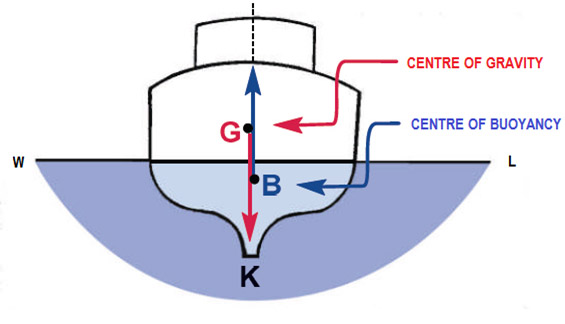The Center of Gravity (CG) of a ship is a crucial point in naval architecture and ship design. It is the point through which the force of gravity acts vertically downward on the ship's entire weight. Understanding and accurately determining the location of the center of gravity is essential for ensuring the ship's stability, safety, and maneuverability. Here's more information about the center of gravity on a ship:
Definition: The Center of Gravity (CG) is the point at which the entire weight of the ship can be considered to be concentrated for stability and balance calculations. It is usually expressed in terms of its vertical distance above a reference point, often the keel.
Significance: The center of gravity is a fundamental parameter in ship design, stability analysis, and operational considerations. It directly impacts a ship's stability, trim, draft, and overall performance. Properly managing the center of gravity is essential for safe and efficient maritime operations.
Position of CG: The position of the ship's center of gravity is not fixed and can change depending on various factors. Some key considerations include:
- The distribution of weight on the ship, including cargo, fuel, equipment, and passengers.
- Variations in cargo loading and unloading during a voyage.
- Consumption of fuel and other consumables.
- Structural modifications and maintenance.
Calculating the Center of Gravity:
- For a ship in its initial design phase, naval architects and designers calculate the approximate position of the center of gravity based on the expected weight distribution.
- For existing ships, the center of gravity can be determined experimentally or through precise measurements.
- It is crucial to take into account the positions of all significant components on the ship, including the weight of the ship's structure, machinery, cargo, fuel, and ballast.
Stability Considerations: The position of the center of gravity is a critical factor in determining a ship's stability. It is used to calculate the metacentric height (GM), which is a measure of the ship's initial stability. A positive GM indicates that the ship has initial stability and will return to an upright position when tilted. A negative GM suggests instability, which can lead to capsizing.
Trim and Draft: The CG's vertical position also affects the ship's trim (the longitudinal balance) and draft (the depth to which the ship sits in the water). Balancing the CG correctly is essential for maintaining the desired trim and draft.
Operational Implications: Ship operators and captains need to be aware of the ship's center of gravity and ensure that changes in weight distribution do not compromise stability. Proper ballasting and cargo distribution are essential for maintaining the CG within safe limits.
In summary, the Center of Gravity (CG) of a ship is a vital parameter that influences the ship's stability, trim, and draft. Properly managing the CG, along with other stability considerations, is essential for ensuring the safety and seaworthiness of the vessel during its operational life.




No comments:
Post a Comment